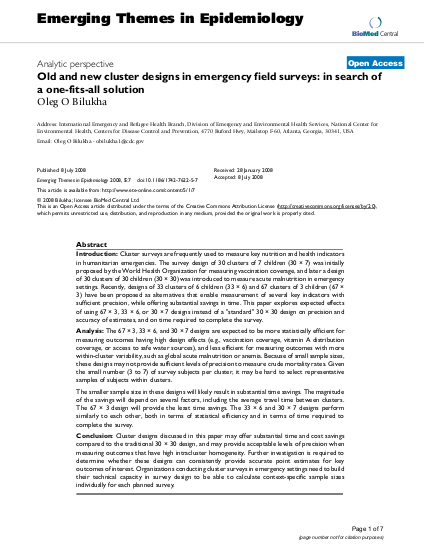
Cluster surveys are frequently used to measure key nutrition and health indicators in humanitarian emergencies. The survey design of 30 clusters of 7 children (30 x 7) was initially proposed by the World Health Organization for measuring vaccination coverage, and later a design of 30 clusters of 30 children (30 x 30) was introduced to measure acute malnutrition in emergency settings. Recently, designs of 33 x 6 and 67 x 3 have been proposed as alternatives that enable measurement of several key indicators with sufficient precision, while offering substantial savings in time. This paper explores expected effects of using 67 x 3, 33 x 6, or 30 x 7 designs instead of a 'standard' 30 x 30 design on precision and accuracy of estimates, and on time required to complete the survey. The 67 x 3, 33 x 6, and 30 x 7 designs are expected to be more statistically efficient for measuring outcomes having high design effects (for example, vaccination coverage, vitamin A distribution coverage, and access to safe water sources), and less efficient for measuring outcomes with more within-cluster variability, such as global acute malnutrition or anaemia. Because of small sample sizes, these designs may not provide sufficient levels of precision to measure crude mortality rates. Given the small number (3 to 7) of survey subjects per cluster, it may be hard to select representative samples of subjects within clusters. The smaller sample size in these designs will likely result in substantial time savings. The magnitude of the savings will depend on several factors, including the average travel time between clusters. The 67 x 3 design will provide the least time savings. The 33 x 6 and 30 x 7 designs perform similarly to each other, both in terms of statistical efficiency and in terms of time required to complete the survey. Cluster designs discussed in this paper may offer substantial time and cost savings compared to the traditional 30 x 30 design, and may provide acceptable levels of precision when measuring outcomes that have high intracluster homogeneity. Further investigation is required to determine whether these designs can consistently provide accurate point estimates for key outcomes of interest. Organisations conducting cluster surveys in emergency settings need to build their technical capacity in survey design to be able to calculate context-specific sample sizes individually for each planned survey.